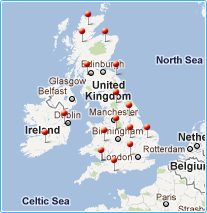Online shop
- Flexible CIGS solar panels
- Semi-flexible Solar Panels
- Rigid Frame Solar Panels
- Folding Solar Panels
- Semi-flexible Solar Kits
- Rigid Frame Solar Kits
- Dual Battery Solar Kits
- Solar Charge Controllers
- Wind Power
- Inverters
- Batteries
- Battery Chargers & Monitors
- Portable Power Stations
- Vehicle Power Management
- Complete Renewable Systems
- UPS Systems
- Solar Lighting Systems
- Cable
- Accessories
- Discounted Items
Didn't find products you were looking for?
Tell us about them! We might have these products in stock, but not on the website, or may be we are planning to restock them soon.
Testimonials:
Splendid system. Sensible price for the package. Excellent results. Quote me.
Simon (Swindon, Wilts, UK)
We are a trusted supplier to thousands of UK clients

Articles
Introduction to Low-Frequency Inverters
For those who are unaware, the purpose of an off-grid inverter is simple, yet incredibly important for anyone who is looking to set up an off-grid or back up power system, including solar powered systems. Inverters convert the DC power stored within a battery (direct current, 12V, 24V or 48V) into AC power (alternating current, 230-240V) that can be used to run your household items and electrical appliances, from fridges to televisions to mobile phone chargers. Inverters are an essential item for anyone without access to a mains power source, as they can easily provide a plentiful amount of electricity.
Inverters come in many different shapes and sizes, and vary in a diverse amount of ways. There are two main contrasting characteristics between different types of off-grid inverter:
- The type of power output, categorised by which sine wave it uses – modified or pure sine wave (see more details in our article on this subject). Photonic Universe only stocks pure sine wave inverters, which are more efficient and have a broader range of suitable appliances they can power compared to modified sine wave inverters.
- What internal frequency the inverter circuits operate at - low frequency or high frequency (not to be confused with AC power output frequency which is a standard 50Hz for our inverters).
We are pleased to add low-frequency inverters to our catalogue, and this article is going to help anyone who is looking to buy an inverter find out whether a low-frequency inverter is right for them, so that they can make an informed and confident purchase.
Low-frequency inverters have the advantage over high-frequency inverters in two fields: peak power capacity, and reliability. Low-frequency inverters are designed to deal with higher power spikes for longer periods of time than high-frequency inverters. Power spikes can occur for a number of reasons (e.g. devices like power tools, pumps, vacuum cleaners and other appliances with electric motors require high starting power); when inverters experience such spikes, they can endure the increased power for a short period of time before shutting down in order to prevent any damage being done to them. Low-frequency inverters have much greater peak power capacity to handle large loads with power spikes than high-frequency inverters. In fact, low-frequency inverters can operate at the peak power level which is up to 300% of their nominal power level for several seconds, while high-frequency inverters can operate at 200% power level for a small fraction of a second. The second main difference is reliability: low-frequency inverters operate using powerful transformers, which are more reliable and sturdy than the high-frequency inverter’s MOSFETs, which use electronic switching and more prone to damage, particularly at high power levels.
In addition to these qualities, low-frequency inverters come with a wide range of technical features and capabilities which most high-frequency inverters lack; these include a built-in battery charger; UPS (Uninterruptible Power Supply) functions; by-pass mode with no battery connected; power saving mode; various charge settings (like different battery types and charging voltages).
In terms of other differences, low frequency inverters are designed for large off-grid power systems and are more suitably equipped for powerful appliances; therefore, they are typically within the high power category of invertor, with their power levels normally within the thousands, typically 2000W-3000W and above (high frequency inverters are also available in lower power categories such as 300W, 600W, 1000W, 1500W etc.) In addition, in most cases low frequency inverters do not include mains power sockets – they come with terminals where AC wires should be connected which then connect to mains sockets.
Low-frequency inverters are not ideal for everyone; they’re very large and are considerably heavier than high-frequency inverters, and would be best suited for those who either are building an off-grid power system with no significant power restrictions, or who run powerful appliances and devices with electric motors like power tools, washing machines, vacuum cleaners and air conditioners. Low-frequency inverters are also best suited for those who want to power various kitchen appliances such as refrigerators, microwaves, dishwashers and ovens.
Enhanced peak performance capacity and improved reliability of low frequency inverters mean that they cost more than high frequency inverters. If you do not consume a lot of energy and you only have small appliances that you need to power, or you have limited space for an inverter, then a high frequency inverter would be more suitable for you.
Low-frequency inverters remain a fantastic investment for anyone who has a lot of powerful electrical appliances in a place with limited or no access to standard electricity. Coupled with a suitable solar power kit, low frequency inverters can not only to provide a reliable backup power solution, but completely replace conventional electricity by the same quality power supply. The price you would pay for a low frequency inverter over a high frequency inverter should be considered a long term investment, given how unlikely the low frequency inverter is to break down. They are indeed bigger, stronger, and tougher.
© Photonic Universe Ltd, 2014









